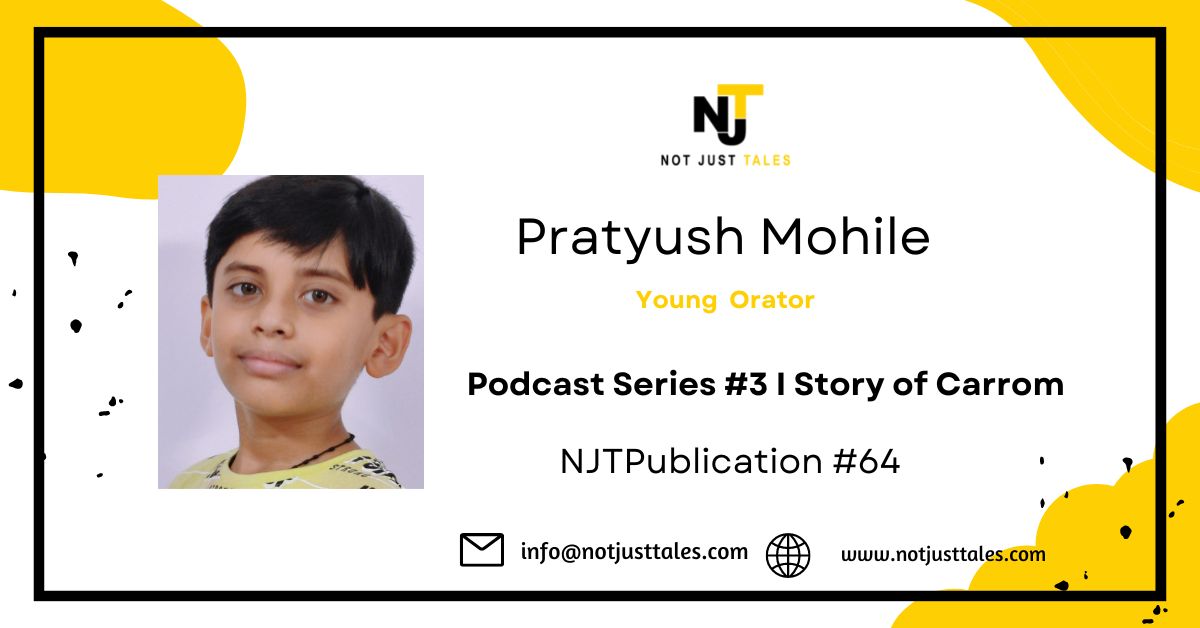Podcast Series#3 I Indian Game Carrom I Student Pratyush Mohile I Public Speaking Through Applied Storytelling & Theatre
By admin in Public Speaking through Stories on November 26, 2022

A short writeup on the indigenous game of India- Carrom, written by our student Pratyush Mohile.
Pratyush is 10 years old, a young orator from Mumbai. We are proud to have him as a student of the Little Kathakar Program, an Online Public Speaking through Applied Storytelling & Theatre Program under the mentorship of Trainer Khusshbo Chokhaani. We congratulate Pratyush for this exemplary true self-expression.
The Game of Carrom
Imagine a war for the queen, everyone fighting for the coins, aiming for pockets, and most significantly fighting for good striking and you win it. Hahaha. Hang on. Before you draw an assumption, let me tell you that I am not talking about a real war but the game of carrom.
There would hardly be anyone who wouldn’t be familiar with the game of carrom. Played by families, including children and at social functions, all of us would have some or other memories attached to this tabletop game.
Unlike chess, billiards, etc., carrom has always been a game for the common folk played for simple pleasures. It requires very little investment with just a board, 19 pieces, and a striker. This is why it has always been a very popular pastime.
It’s a game of Indian origin and is renowned in the subcontinent of India. It is known by varied names in different languages. In South Asia, many clubs and cafés hold regular tournaments. The word carrom originated in Timor Southeast Asia from there it traveled to the Portuguese who found it to be convenient for the Malabar coast of India.
The All India Carrom Federation (AICF) is India‘s national level governing body for this indigenous game. It sanctions six to seven national-level tournaments per year. Srinivas A. and Maria Irudayam S. Ilavazhagi are a few prominent players. Rashmi Kumari, S. Radhakrishnan, and Chamil Cooray are some other champions of the game who have done their masters in carrom.
Over the years, the game has become popular in South Asia, and Arabia, including Saudi Arabia, Kuwait, and Bahrain. It is gaining popularity in the west also. Regularly organized tournaments are being held in India and other parts of the world.
With the advent of the internet and the rise of social gaming, carrom game is also available online. One can choose to play against the computer or play against other players. The rules of the game over the years have remained unchanged.
Folks, I will tell you a short story regarding the rules of carrom.
It was Rohan’s sixth birthday. When he unboxed his first gift, he saw that it was a carrom board. It had 19 carrom men, a striker, and a small sachet of boric powder. He was amused but did not know how to play the game. Suddenly the board was alive and said, “I will teach you how to play carrom”. “You can talk? That’s great! Now please explain to me how to play it,” said Rohan excitedly.
“Rohan, before we begin why don’t you don’t call your brother? I shall be able to explain the rules better. This game requires a minimum of two and a maximum of four players,” said the carrom board. Rohan called out his brother Darsh. He came in quickly and both sat opposite to Rohan to hear the rules of the game.
The broad objective of the game is to use the striker with a flick of the finger to drive the carrom men into any of the four corner pockets. The game aims to pocket one’s nine carrom men along with the queen before your opponent, explained the board.
The board then called out and said, “Boric powder, tell your role.” “My role is to make the board smooth but don’t put too much of me. Otherwise, it would make the board slippery,” said Boric Powder.
The Carrom Board continued his story: “Carrom Men that are not touching the player’s baseline, or that are behind the baseline can be hit directly by the Striker. If the Carrom Men are touching the baseline or are in front of it, they can only be hit with a Striker that has rebounded off the side of the Carrom Board or another Carrom piece. If you strike your last piece directly before the Queen you will have to pay a penalty. If during a player’s turn a Carrom piece is knocked off the board, it is returned to the center of the board. Any overlapping or pieces that stay on their edge are left as is. If there is already a piece in the center of the board, the piece should be returned to touch as much of the red center circle as possible. If the center circle is covered completely, the piece is placed opposite the player who will strike next behind the red circle. A player may have to pay a penalty if they strike their last Carrom man on the board before the Queen.”
“What If a player pots their opponent’s color?” asked, Darsh. Carrom’s Board replied, “Player loses their turn. If the player sinks their opponent’s last piece, they lose the board and have 3 points deducted from their score.If a player pots their last Carrom piece before the Queen, that player loses the board and has three points deducted from their total score.If correctly pocketed, the Carrom men remain in the pocket unless they are owed to the opposite player.”
Thanks for helping us out. Now we know how to play carrom.
“You are welcome”, said the carrom board.
“This was an attempt from my side to share a short glimpse of the indigenous game of Carrom. Hope you enjoyed the information in story form.”-Pratyush
Leave your valuable comments for encouraging our students to innovate, explore and express more.


Recent Comments